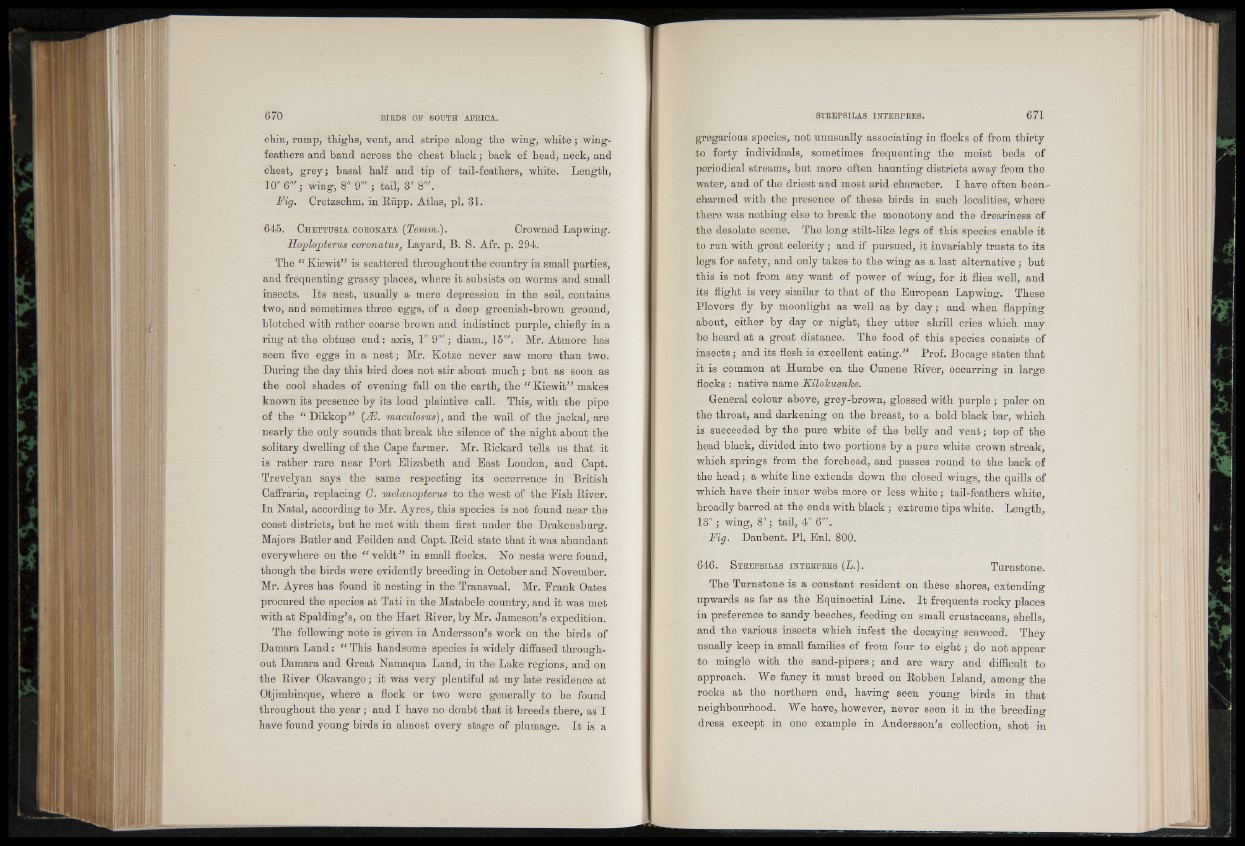
chin, rump, thighs, vent, and stripe along the wing, white; wingfeathers
and band across the chest black; back of head, neck, and
chest, grey; basal half and tip of tail-feathers, white. Length,
10" 6'"; wing, 8" 9'" ; tail, 3" 8'".
Fig. Cretzschm. in Rupp. Atlas, pi. 31.
645. C h e t t u s i a c o r o n a t a ( T e m m .) . Crowned Lapwing.
H o p l o p t e r u s c o r o n a t u s , Layard, B. S. Afr. p. 294.
The “ Kiewit” is scattered throughout the country in small parties,
and frequenting grassy places, where it subsists on worms and small
insects. Its nest, usually a mere depression in the soil, contains
two, and sometimes three eggs, of a deep greenish-brown ground,
blotched with rather coarse brown and indistinct purple, chiefly in a
ring at the obtuse end: axis, 1" 9'" ; diam., 15'". Mr, Atmore has
seen five eggs in a nest; Mr. Kotze never saw more than two.
During the day this bird does not stir about much; but as soon as
the cool shades of evening fall on the earth, the “ Kiewit” makes
known its presence by its loud plaintive call. This, with the pipe
of the “ Dikkop” (JE. maculosus), and the wail of the jackal, are
nearly the only sounds that break the silence of the night about the
solitary dwelling of the Cape farmer. Mr. Rickard tells us that it
is rather rare near Port Elizabeth and East London, and Capt.
Trevelyan says the same respecting its occurrence in British
Caffraria, replacing 0. melanopterus to the west of the Pish River.
In Natal, according to Mr. Ayres, this species is not found near the
coast districts, but he met with them first under the Drakensburg.
Majors Butler and Feilden and Capt. Reid state that it was abundant
everywhere on the “ veldt ” in small flocks. No nests were found,
though the birds were evidently breeding in October and November.
Mr. Ayres has found it nesting in the Transvaal. Mr. Frank Oates
procured the species at Tati in the Matabele country, and it was met
with at Spalding’s, on the Hart River, by Mr. Jameson’s expedition.
The following note is given in Andersson’s work on the birds of
Damara Land: “ This handsome species is widely diffused throughout
Damara and Great Namaqua Land, in the Lake regions, and on
the River Okavango; it was very plentiful at my late residence at
Otjimbinque, where a flock or two were generally to be found
throughout the year; and I have no doubt that it breeds there, as I
have found young birds in almost every stage of plumage. I t is a
gregarious species, not unusually associating in flocks of from thirty
to forty individuals, sometimes frequenting the moist beds of
periodical streams, but more often haunting districts away from the
water, and of the driest and most arid character, I have often been-
charmed with the presence of these birds in such localities, where
there was nothing else to break the monotony and the dreariness of
the desolate scene. The long stilt-like legs of this species enable it
to run with great celerity; and if pursued, it invariably trusts to its
legs for safety, and only takes to the wing as a last alternative; but
this is not from any want of power of wing, for it flies well, and
its flight is very similar to that of the European Lapwing. These
Plovers fly by moonlight as well as by day; and when flapping
about, either by day or night, they utter shrill cries which may
be heard at a great distance. The food of this species consists of
insects; and its flesh is excellent eating.” Prof. Bocage states that
it is common at Humbe on the Cunene River, occurring in large
flocks : native name KilolcumTce.
, General colour above, grey-brown, glossed with purple ; paler on
the throat, and darkening on the breast, to a bold black bar, which
is succeeded by the pure white of the belly and vent; top of the
head black, divided into two portions by a pure white crown streak,
which springs from the forehead, and passes round to the back of
the head; a white line extends down the closed wings, the quills of
which have their inner webs more or less white; tail-feathers white,
broadly barred at the ends with black; extreme tips white. Length,
13"; wing, 8"; tail, 4" 6'".
Fig. Daubent. PI. Enl. 800.
646. S t r e p s il a s in t e r p r e s (L.). Turnstone.
The Turnstone is a constant resident on these shores, extending
upwards as far as the Equinoctial Line. It frequents rocky places
in preference to sandy beeches, feeding on small crustaceans, shells,
and the various insects which infest the decaying seaweed. They
usually keep in small families of from four to eight; do not appear
to mingle with the sand-pipers; and are wary and difficult to
approach. We fancy it must breed on Robben Island, among the
rocks at the northern end, having seen young birds in that
neighbourhood. We have, however, never seen it in the breeding-O
dress except in one example in Andersson’s collection, shot in